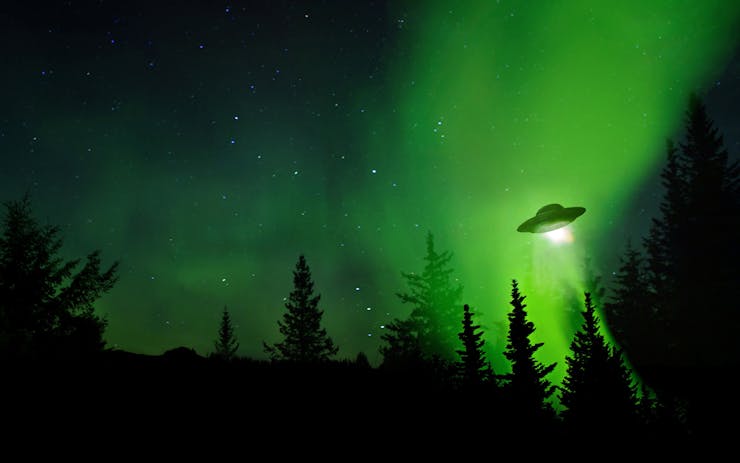The mood in the Melrose Market was tentative and excited. The atmosphere in the high ceilinged room was underpinned by space-age sounds that radiated from a synthesizer just out of view. Here, at Higher Education, the Who’s Who of the cannabis industry gathered, sitting or standing amongst an enclave of friends and associates, eager to indulge in a collective sense of mystery and wonderment congregated under a single roof.
Higher Education, for those who don’t know, is a lecture series designed around commonly held curiosities and subjects of interest. These talks are hosted by The Goodship Company, a Seattle-based cannabis-infused edible producer, and they seek to change the way we think about what we do when we consume cannabis. This elevation of cannabis culture was accessible, digestible (rim shot), and designed so anyone can explore a heightened state of mind with the aid of fascinating speakers, writing materials, and quality libations.
This lecture was the first of 2017, entitled Seth Shostak on “Where Are the Extraterrestrials?”
Wondering about life is part of the human condition. Whether exemplified by our inclination to empathize with animals or in the casual search for aliens while stargazing, man has sought and continues to seek an understanding of life beyond himself. SETI, the Search for Extraterrestrial Intelligence, is one of the few agencies combing the sky for signs of life beyond Earth. To some, this subject is taboo or nonsense, like ghosts and Sasquatch, but to others, the search for extraterrestrial life is the search for the most important human discovery conceivable.
Where Are the Extraterrestrials?

SETI’s Senior Astronomer Seth Shostak strode eagerly across the floor as he debunked the Roswell alien crash site. Imagine driving your car across the country and crashing into your garage door. A roar of laugher erupted from the crowd. This Higher Education lecture was turning out to be exuberant and comical while revealing some of the core beliefs behind a deftly pragmatic search for life beyond our solar system.
For instance, Shostak believes that if life is reaching out to us, the likelihood is that it will do so in the form of artificial intelligence, i.e. a robotic probe. This supposition was based on the problems we “squishy humans” contend with when considering the habitability challenges of long distance space travel. Naturally, a lifeless, intelligent machine broadcasting a jolly ol’ howdy-do would go faster and further toward touching parts of space beyond the reach of organic life.
That is why SETI and other SETI-focused radio telescope arrays have been constructed in the last half-century. Coincidently, Seattle’s own Paul Allen helped fund the One Hectare Telescope (1HT), currently known as the Allan Telescope Array. This telescope array is under construction and consists of 42 dishes arranged at the Hat Creek Radio Observatory in California. This is only one of several radio arrays around the world, including the Low Frequency Array (LOFAR) in the Netherlands, the Murchison Widefield Array (MWA) in Australia, and the Lovell Telescope in the United Kingdom.
Questions from the Crowd

Dr. Shostak took questions from members of the audience (some more stoned than others) at the end of the lecture.
One attendee asked, “If the SETI Institute received NASAs funding, how would the search for extraterrestrial intelligence be improved?” Seth quickly retorted with something like, “Well, first, building a radio telescope array on the moon would solve a lot of our problems. But more dishes is the more reasonable answer.” Apparently, Earth emits a great deal of noise and radio interference, e.g. placing an array in space would decrease interference while optimizing the computational power of the existing technological infrastructure.
So, where are they? The short answer is really, really, really, really, really far away, if they are out there. But Shostak believes that the rise of AI and machine learning with accelerate their search by an order of magnitude, hopefully leading to a profound discovery within our lifetime.
Shostak’s animated persona and collection of slick scientific one-liners made him a truly entertaining speaker and an intellectual of the grandest caliber. Stuffy subjects like astronomy and architecture can feel rigid and algebraic, but Higher Education and its formal informality transmits these heady frequencies through a medium of inclusive curiosity and discovery.
This lecture, if anything, was an embodiment of that sentiment, echoing ever so slightly the sense of heady wonder inherent to cannabis, too. And with seven new, possibility habitable Earth-sized planets discovered only 40 lightyears away (approximately 235 trillion miles from Earth), which in relationship to the size of our galaxy, is in our backyard; who knows, intelligent life could be out there, puffing on space cannabis, gazing up into the sparkling, inky cosmos, wondering, like we wonder, is anyone out there?





